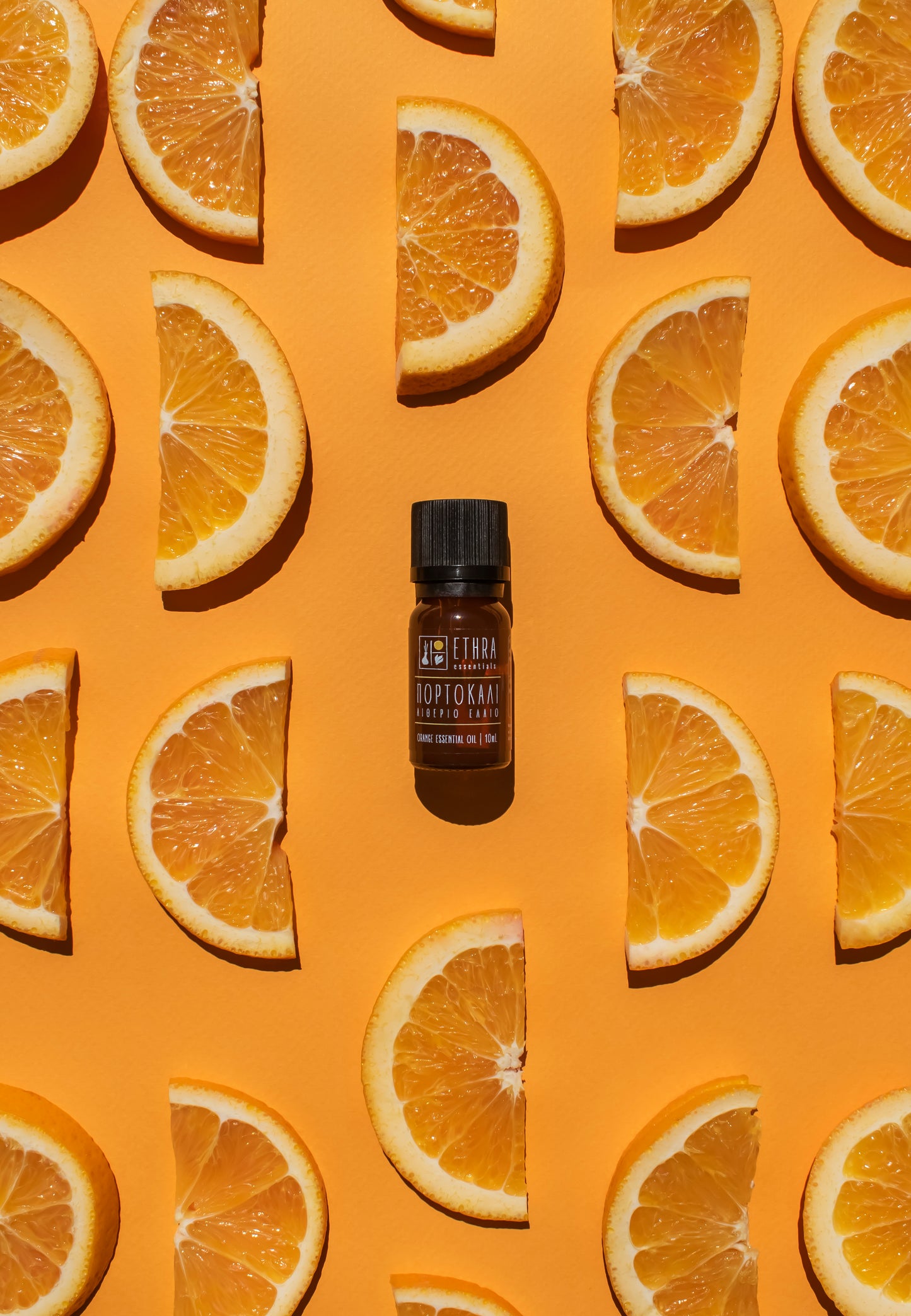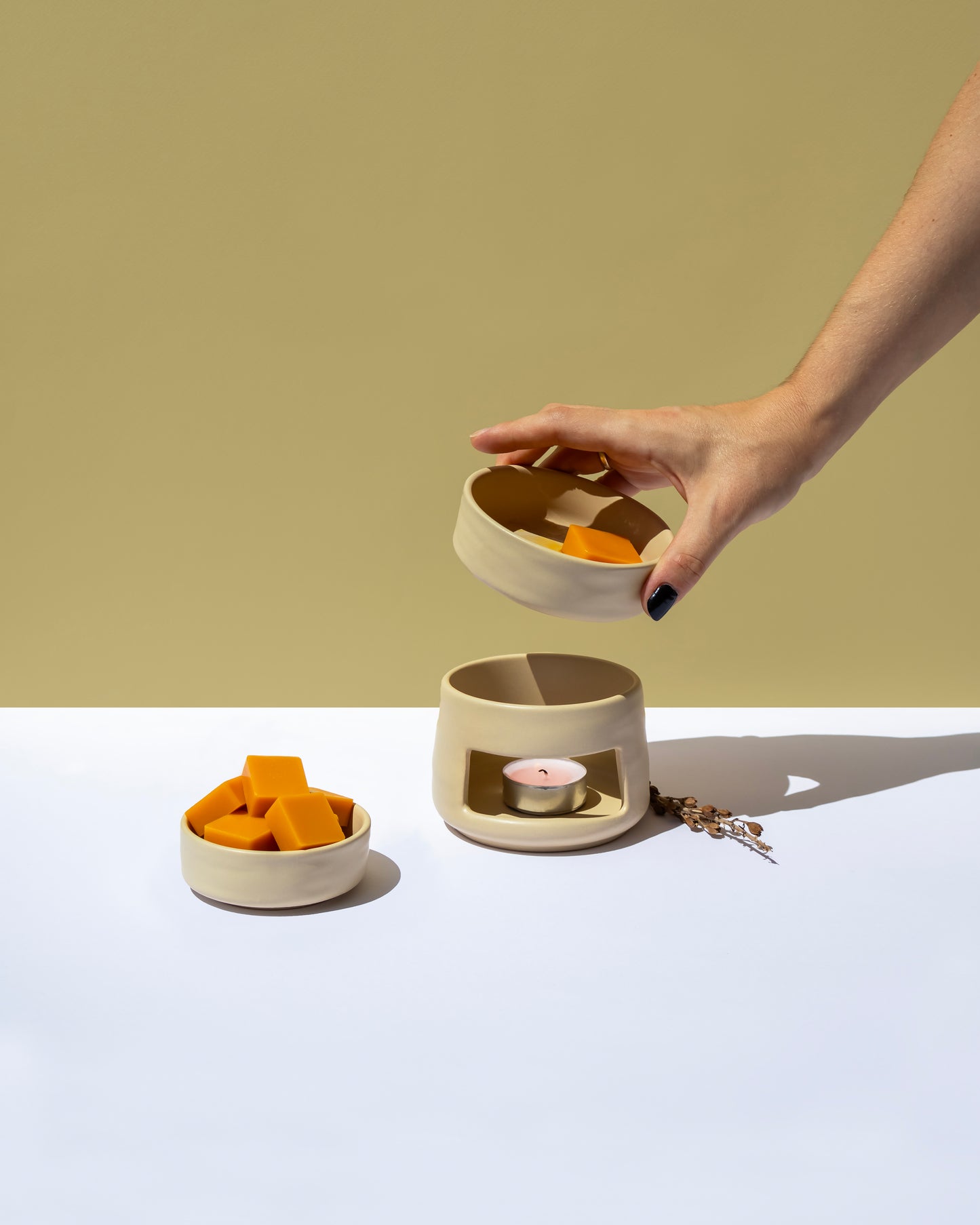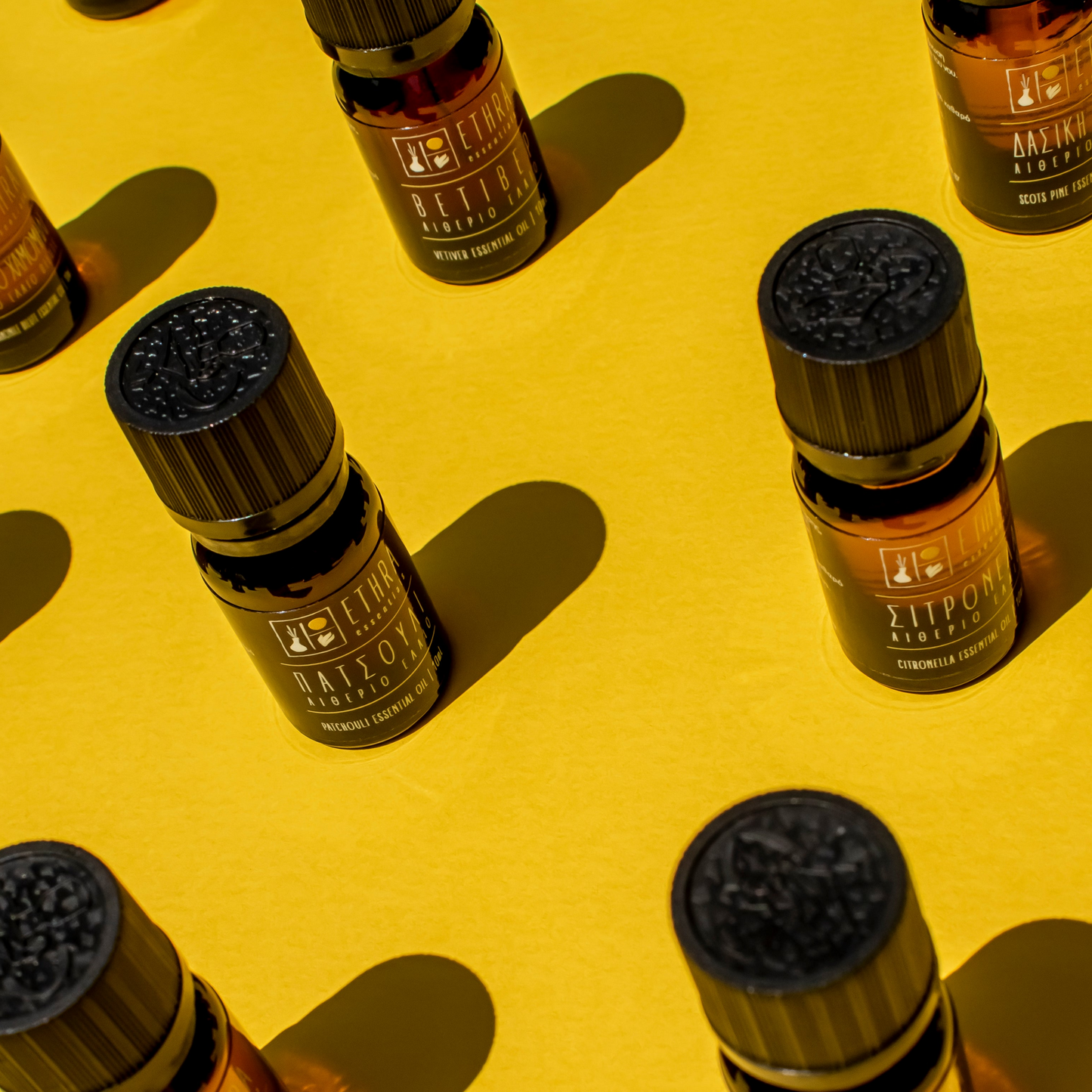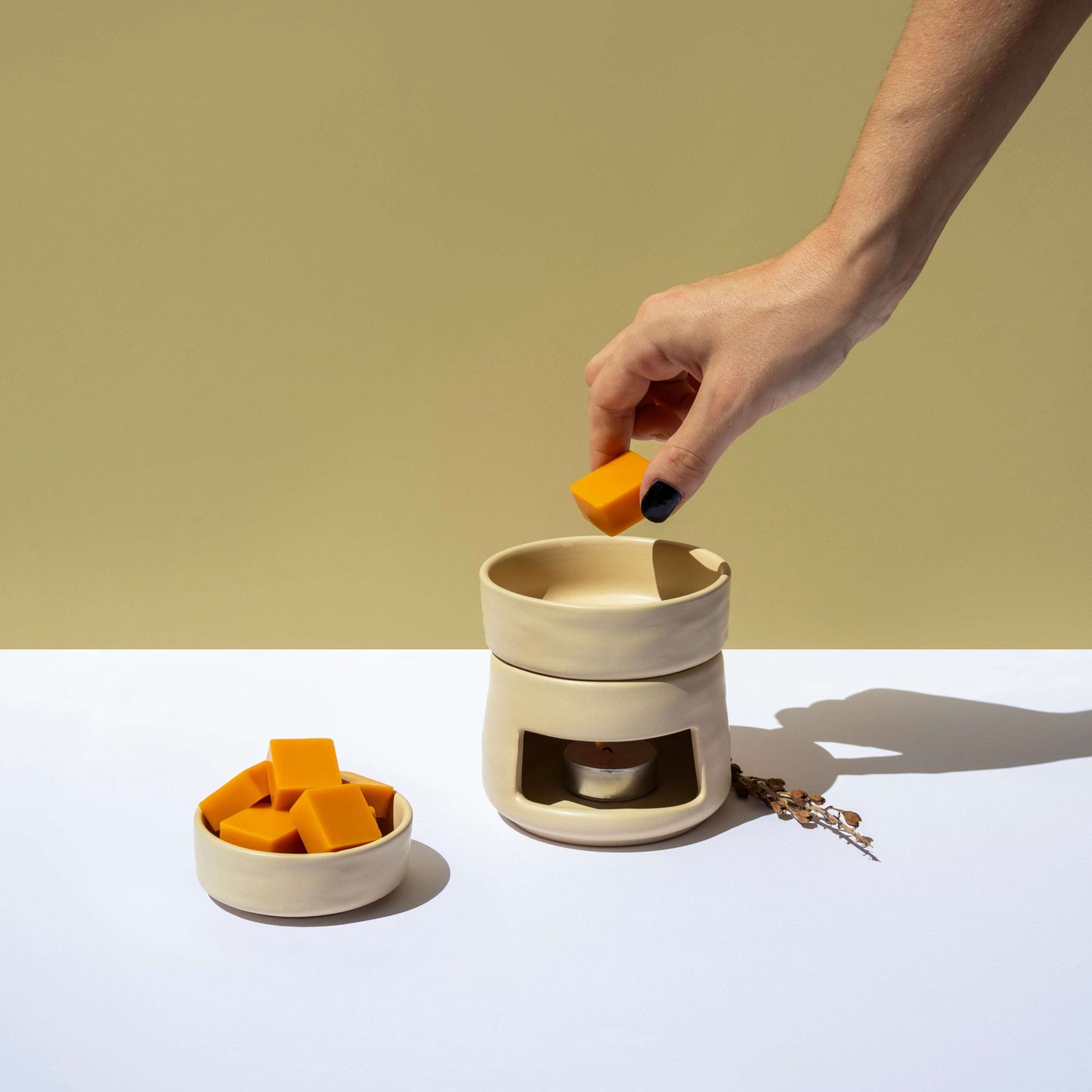Find them at a -15% discount with the purchase of 5 essential oils or more!

Synergy of Essential Oils | Creating Blends Based on Aroma Type
Essential oils can be divided according to their type of aromas. These categories are 6 and include floral, spicy, woody, medicinal, citrus and herbal.
Floral

Floral essential oils are derived from flowers and petals through steam distillation or extraction. Their aromas can range from light to rich and complex.
Lavender (Lavandula angustifolia):
Lavender essential oil has a sweet, herbaceous and floral aroma with subtle notes of freshness. It is versatile and blends well with other essential oils. It can add a calming and balancing note to blends.
Rose (Rosa damascena):
Rose essential oil is one of the most precious and luxurious floral essential oils. It has a deep, rich and sweet floral aroma with fresh tones. Due to its strong smell, it is often used in small quantities and can be combined well with citrus oils, jasmine and sandalwood.
Ylang Ylang (Cananga odorata):
Ylang ylang essential oil has a sweet, floral and slightly fruity aroma with tropical undertones. It can pair well with other floral oils as well as woodier scents like cedarwood and patchouli.
When mixing flower essential oils with other classes of essential oils, it is important to consider the intensity of the aromas and their healing properties. Here are some tips for creating balanced and enjoyable mixes:
Florals can be used either alone or in combination with others.
- If we want to give a cooler note, we add some herbal essential oil such as rosemary.
- If we want to lighten a floral essential oil that seems heavy to us and want a more refreshing smell, we add a citrus like orange, bergamot and lemon.
- If we want to warm the aroma, then we use a spicy essential oil such as ginger or clove.
- If we want to make the aroma more earthy and harmonious then we add a woody essential oil such as sandalwood, cedarwood or frankincense.
Spicy

Spicy essential oils come from seeds, barks, roots, etc. They are characterized as warm and rich aromas reminiscent of kitchen spices. When mixed with other essential oils, they add warmth, depth and complexity to the blend.
Cinnamon (Cinnamomum verum):
Cinnamon essential oil has a strong, sweet and spicy aroma with a hint of woody undertones. It can add warmth and a touch of sweetness to blends. However, it should be used sparingly as its scent can be quite strong.
Ginger (Zingiber officinale):
Ginger essential oil has a warm, spicy aroma with a hint of citrus freshness. It is refreshing and can pair well with citrus essential oils, as well as woody and herbal essential oils.
Black pepper (Piper nigrum):
Black pepper essential oil has a strong, spicy aroma. It can provide a warm and stimulating element to blends, complementing citrus and herbal essential oils.
Clove (Syzygium aromaticum):
Clove essential oil has a strong, spicy and sweet aroma with a hint of warmth and richness. It can be quite powerful, so we use it sparingly. Clove blends well with citrus and woody essential oils.
Spicy essential oils can be used either alone or in combination with others.
- If we want to give a refreshing note, then we add citrus essential oil such as orange, lemon or bergamot.
- If we want to give a note of harmony, then we add a floral essential oil such as ylang ylang.
- If we want to add a more soothing note, then we add a woody essential oil such as cedarwood, sandalwood and frankincense.
- If we are looking for a more unique aroma, then we add essential oils of herbs such as rosemary and thyme.

These essential oils are complex and special. They have an earthy and "thick" smell. It is both earthy and sensual. They come from the bark, roots and sometimes the heartwood of trees and shrubs. They offer a sense of stability and connection with nature.
Cedarwood (Cedrus virginiana):
Cedarwood essential oil has a warm, woody and slightly sweet aroma with earthy undertones. It is often used to promote a sense of calm and can combine well with citrus, herbal and floral essential oils.
Sandalwood (Amyris balsamifera):
Sandalwood essential oil has a rich, woody and sweet aroma with subtle floral notes. It is prized for its calming effects and can be harmoniously combined with floral essential oils, as well as spicy and citrus.
Frankincense (Boswellia carterii):
Frankincense essential oil has a resinous, woody and slightly citrusy aroma with a hint of sweetness. It is often used for meditation and can be combined well with citrus, herbal and spicy essential oils.
Patchouli (Pogostemon cablin):
Patchouli essential oil has an earthy, musky and slightly sweet aroma with herbal undertones. It can add depth and grounding to blends and pairs well with floral, citrus and spicy essential oils.
Vetiver (Vetiveria zizanioides):
Vetiver essential oil has a deep, smoky and earthy aroma with hints of sweetness. It is known for its calming and grounding effects and can pair beautifully with floral, citrus and spicy essential oils.
- For a refreshing blend we combine woody essential oils such as cedarwood or sandalwood with citrus essential oils such as bergamot, lemon or grapefruit.
- For a harmonious blend we combine woody essential oils such as frankincense or patchouli with floral essential oils such as lavender, rose or jasmine.
- For a warm and comforting blend, mix woody essential oils with spicy essential oils such as ginger or clove.
- For an earthy and refreshing blend, we combine woody essential oils with herbs such as rosemary, thyme or sage.
Medicinal

Medicinal essential oils have a clean and sharp smell. They often come from plants traditionally used for their healing properties.
Tea tree (Melaleuca alternifolia):
Tea tree essential oil has a fresh, medicinal and slightly camphorous aroma. It is known for its antibacterial and antifungal properties. Tea tree combines well with citrus, herbal and some floral essential oils.
Eucalyptus (Eucalyptus globulus):
Eucalyptus essential oil has a strong, camphorous and tonic aroma. Often used for respiratory support. Eucalyptus mixes well with other camphorous essential oils, as well as with citrus essential oils.
Peppermint (mentha piperita):
Peppermint essential oil has a refreshing and cool aroma. It is known for its headache-relieving properties. Peppermint blends well with citrus, herbal and other medicinal essential oils.
- We combine eucalyptus, tea tree and peppermint essential oils for a refreshing and supportive blend during times of congestion or seasonal discomfort.
- Mix citrus essential oils such as lemon or orange with rosemary and peppermint for an uplifting and refreshing blend.
Citrus

Citrus essential oils come from the peel of citrus fruits and have very vibrant scents. They lift the mood and create a bright atmosphere.
Orange (Citrus sinensis):
Orange essential oil has a sweet, juicy and happy aroma reminiscent of fresh oranges. It is a popular choice for its tonic effects. Orange blends well with most other essential oils, making it versatile for various blends.
Lemon (Citrus limon):
Lemon essential oil has a clean, lively and bright aroma that can promote clarity and focus. Blends well with other citrus essential oils, as well as herbal and woody essential oils.
Grapefruit (Citrus paradisi):
Grapefruit essential oil has a spicy, invigorating aroma. It is often used to boost mood and promote a sense of vitality. Grapefruit blends well with other citrus essential oils, as well as floral and herbal essential oils.
Bergamot (Citrus bergamia):
Bergamot essential oil has a unique, citrusy and slightly floral aroma. It is known for its calming and balancing effects. Bergamot blends well with other citrus essential oils, floral essential oils and some woody essential oils.
- For a vibrant and uplifting blend that promotes positivity, we combine different citrus essential oils such as orange, lemon and grapefruit.
- For a refreshing scent, mix citrus essential oils with lavender, rosemary or peppermint.
- For balance and grounding, we combine citrus essential oils with woody like cedarwood, sandalwood or frankincense.
- For a bright and harmonious scent, we combine citrus essential oils with floral such as lavender or ylang ylang.







